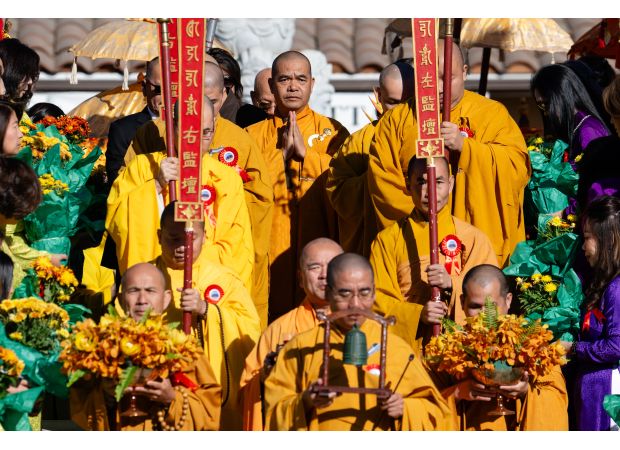New Buddhist temple in Bay Area shows resilience through its vast size.
A Buddhist monk from Vietnam flees persecution and successfully establishes a new place for worship.

On a beautiful Sunday morning, under a clear, blue sky that almost resembled a painting, a joyous celebration was taking place at the Bay Area's newest Buddhist temple. The temple grounds were adorned with vibrant colors as nuns and monks, with closely-shaved heads, paraded in their saffron and lavender robes. They were joined by women in brightly colored dresses, carrying orange flowers, adding to the lively and festive atmosphere. The rhythmic chime of a bell filled the air as the procession made their way towards the grand opening of the Tâm Từ Metta Vietnamese Buddhist temple, which was located on the southern edge of Morgan Hill.
This grand event was attended by hundreds of monks, nuns, faithful followers, and supporters from all over the world. It was a momentous occasion that marked the realization of a long-held dream to bring a piece of Vietnamese culture to the United States. The temple's creators hoped that it would not only serve as a place of worship for the Vietnamese and Buddhist communities but also as a sanctuary for anyone seeking peace and meditation in the bustling Bay Area.
One of the attendees, Long Nguyen from San Jose, shared his thoughts on the temple, saying, "It's more than just a place to practice Buddhism. It's a reminder of our native country, and there has never been anything quite like this in California before."
As the guests took their seats, the local Buddhist community marveled at the temple's grandeur and uniqueness. While there were already several Buddhist communities and temples scattered throughout the Bay Area, the Tâm Từ Metta temple stood out for its exquisite architecture that paid homage to various styles from different regions of Vietnam. The temple and its surrounding garden spanned several acres of land and were beautifully decorated with bamboo, palms, and olive trees. Stone paths were lined with pillars engraved with Buddhist sutras, and there were stunning granite statues and intricately carved facades adorning the area.
The visionary behind the entire complex was Thich Phap Chon, a Vietnamese Buddhist monk and the temple's abbot. Chon had conceived the idea of the temple almost thirty years ago and had finally seen it come to fruition. He became a monk at the tender age of seven in Vietnam but was forced to flee the country in 1989 due to the strict religious regulations imposed by the government. Leaving behind his temple, family, and everything he knew, Chon embarked on a journey that would take him to Hong Kong, the Philippines, and eventually Canada before settling in the United States in 1996.
He shared his emotional journey, saying, "I left my temple, my family, and my country. It was a difficult decision, but I thought to myself, 'We may never get to return to Vietnam, so I'll bring a piece of it with me - the temple and the culture.'"
However, it would take nearly three decades for his dream to come to fruition. Chon founded a Buddhist community, Lieu Quan, in San Jose in 2000, but he lacked the land to build a temple. It wasn't until he discovered the open spaces in Morgan Hill during his daily commutes to Gilroy that he saw the potential for his vision. In 2009, with the help of donations, he purchased a plot of abandoned agricultural land.
Chon recalled, "The land was a mess - piles of trash, debris, and a collapsed greenhouse. Some people who initially supported my vision even doubted that we could turn it into the temple they had hoped for."
Undeterred, Chon was determined to make his dream a reality. He believed in the Buddhist teaching, "No mud, no lotus," which means that suffering can be transformed into joy and beauty. And so, with a group of volunteers, he began the 15-year journey of restoring the land, converting a barn into a temple building, and creating a stunning garden. They even traveled to China to commission sculptures and used reclaimed construction materials to cut costs. Chon himself learned how to operate heavy machinery to personally take part in the construction.
The project also involved nearly a decade of navigating through bureaucratic processes with Morgan Hill, Santa Clara County, and an obscure regulatory body called LAFCO to get the necessary approvals to build the temple on agricultural land.
As the grand opening ceremony continued, performances by various groups added to the celebratory atmosphere. One of the highlights was a performance by Destiny Reyes of West Coast World Martial Arts. The local community was thrilled to have such a magnificent temple in their midst, and it was a proud moment for Thich Phap Chon and his team to see their hard work and determination come to fruition. The temple would not only serve as a place of worship but also as a symbol of hope, resilience, and the beauty of transforming suffering into joy.
The grand opening of the Tâm Từ Metta Vietnamese Buddhist temple was a stunning sight to behold. The picturesque ceremony took place on a beautiful Sunday morning, with not a single cloud in sight and the sky a brilliant shade of Kodachrome-blue. The air was filled with a sense of peace and tranquility, as nuns and monks with shaved heads adorned in saffron and lavender robes led the way. They were accompanied by a line of women dressed in vibrant, colorful dresses, carrying bright orange flowers. The whole procession moved gracefully to the rhythmic sound of a bell, slowly making their way to the brand new Buddhist temple in the Bay Area.
This grand opening was a monumental event for the Tâm Từ Metta Vietnamese Buddhist temple, as it was one of the largest of its kind in the entire Bay Area. Located on the southern edge of Morgan Hill, the temple was a dream come true for the hundreds of monks, nuns, faithful followers, and supporters who had worked tirelessly to bring a piece of Vietnamese culture to the United States. It was a momentous occasion that marked the culmination of decades of hard work and dedication.
For many, this temple was more than just a place of worship. It was a symbol of their native country and a reminder of their roots. As one attendee, Long Nguyen of San Jose, expressed, "It's not just a temple to practice Buddhism, it's a place to remind us of our native country." This sentiment was shared by many who had traveled from across the globe to be a part of this special event.
As the attendees took their seats and prepared for the ceremony to begin, it was clear that this temple was unlike any other in the Bay Area. While there were already several Buddhist communities and temples scattered throughout the region, Tâm Từ Metta stood out for its impressive size and its homage to different styles of Vietnamese architecture. The temple and its surrounding garden covered several acres of land, featuring a stunning landscape of bamboo, palms, olive trees, and lotus-filled pools. Stone paths were lined with pillars engraved with Buddhist sutras, and intricate granite statues stood tall. The complex also included stupas, pagodas, and intricately carved facades that provided shade and added to the overall beauty of the temple.
The mastermind behind this magnificent temple was none other than Thich Phap Chon, a Vietnamese Buddhist monk and the abbot of Tâm Từ Metta. Chon had envisioned this temple nearly thirty years ago and had dedicated his life to making it a reality. His journey had not been an easy one, as he became a monk at the young age of seven in Vietnam. However, in 1989, he was forced to flee his homeland due to religious suppression. He left behind everything he knew, including his temple, family, and country. But he never gave up on his dream of bringing a piece of Vietnam with him to the United States.
Chon's perseverance and determination paid off, as he finally arrived in the United States in 1996 and settled in San Jose. In 2000, he founded the Lieu Quan Buddhist community but lacked the land to build a temple. It wasn't until years later, during his commutes to Gilroy, that he stumbled upon the perfect location in Morgan Hill. With the help of donations, he purchased a plot of abandoned agricultural land in 2009, which he then transformed into the stunning temple and garden that stood before the attendees.
However, the journey to this grand opening was not without its challenges. The land that Chon had purchased was in a state of disarray, filled with piles of garbage, debris, and a collapsed greenhouse. Despite initial doubts from some who had supported his vision, Chon remained determined to turn this mess into a beautiful temple. As he said, "No mud, no lotus," recalling a teaching by monk Thich Nhat Han that suffering can be transformed into joy and beauty.
Over the next fifteen years, Chon and a group of volunteers worked tirelessly to restore the land, transform a barn into a temple building, and bring in trees for the garden. They even traveled to China to commission sculptures and found reclaimed construction materials to cut costs. Chon himself learned how to operate heavy machinery to personally take part in the construction. The project also required nearly a decade of bureaucratic maneuvering, involving multiple government agencies, to get the necessary permissions to build the temple on agricultural land.
As the grand opening ceremony came to an end, it was clear that this temple was not just a place for the Vietnamese and Buddhist communities, but also a refuge for anyone seeking peace and meditation in the Bay Area. It was a testament to the determination and dedication of Thich Phap Chon and all those who had worked tirelessly to make this dream a reality. The Tâm Từ Metta Vietnamese Buddhist temple was a beautiful symbol of compassion and loving-kindness, and it would continue to inspire and bring joy to all those who visited.






